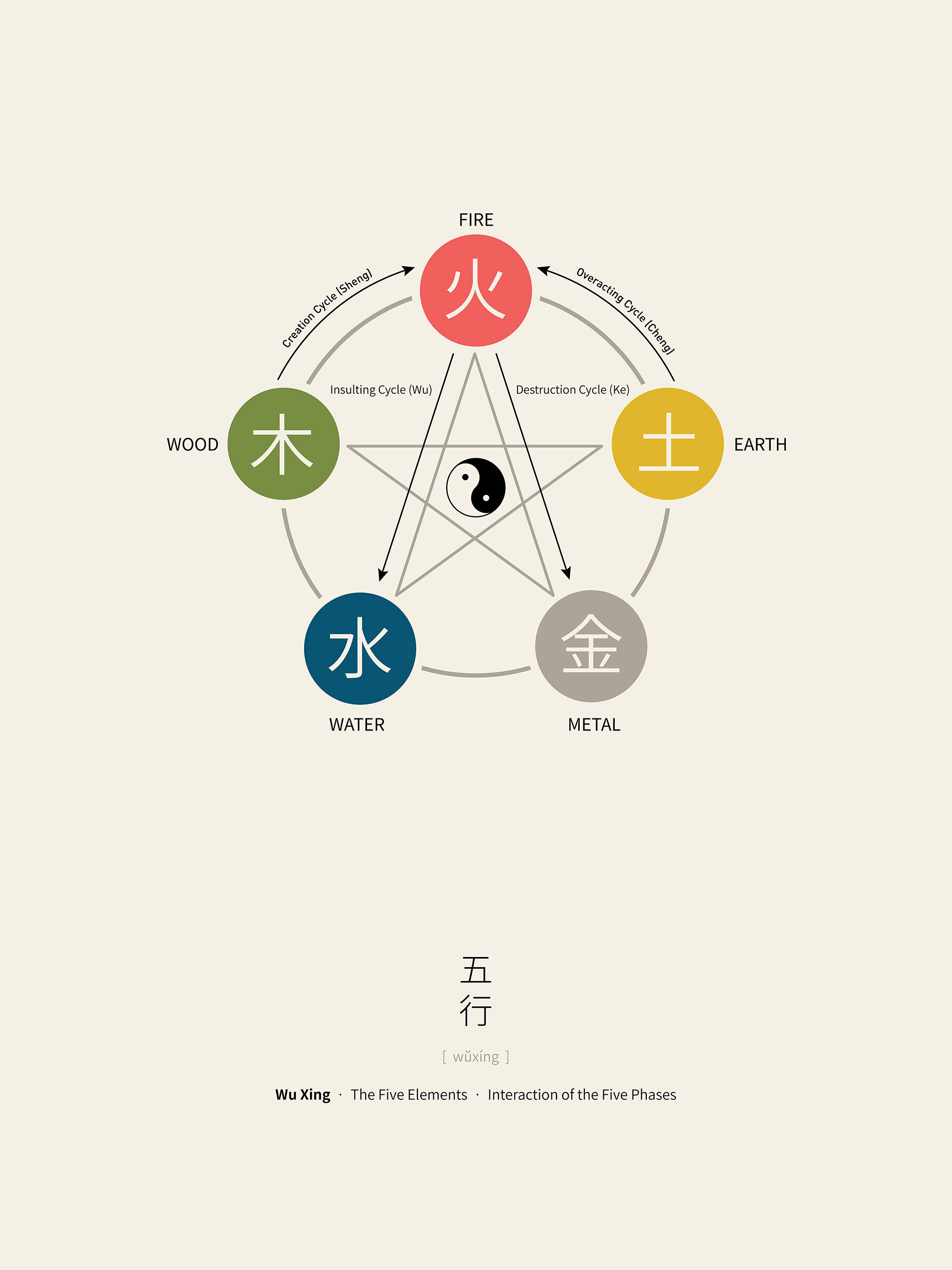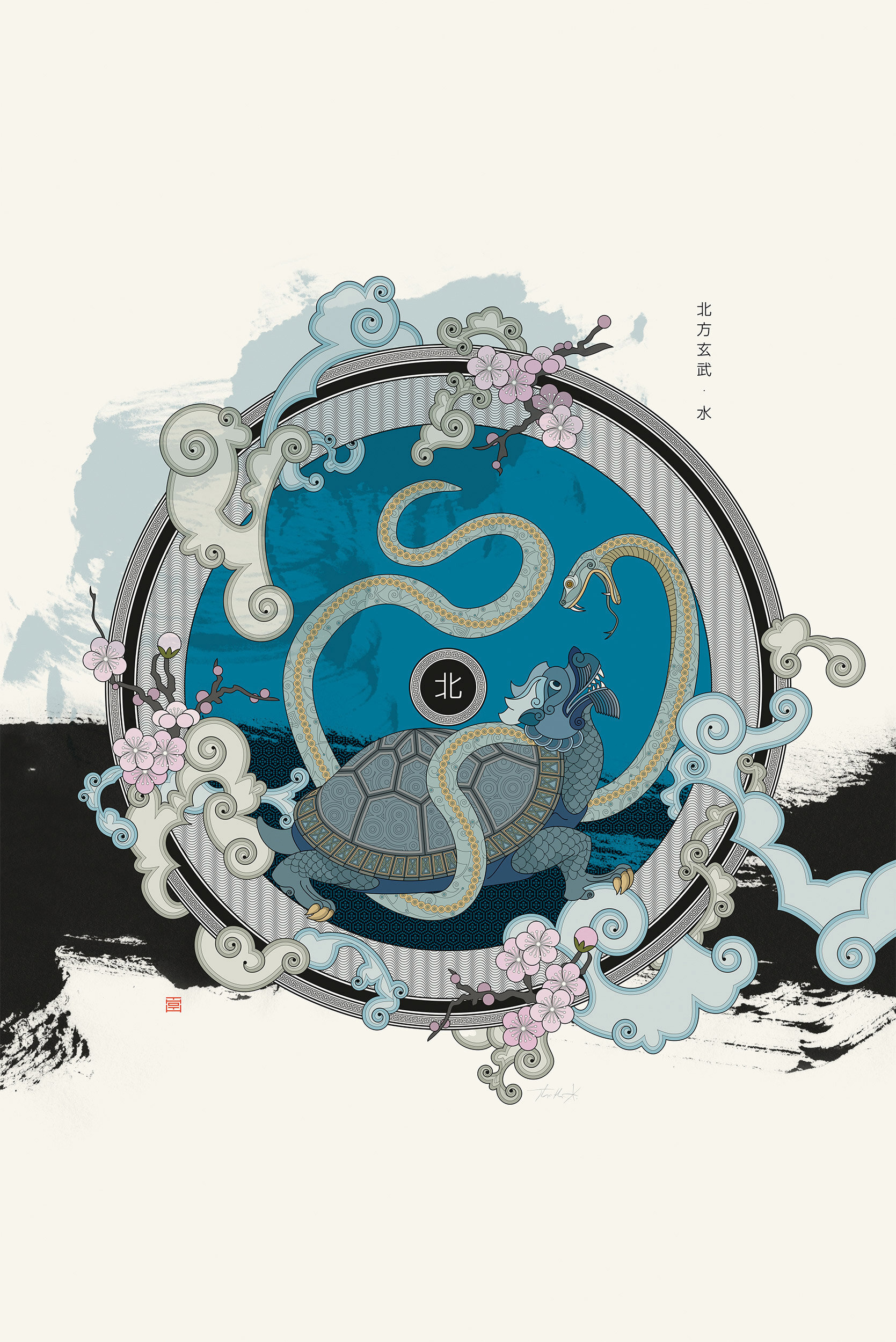The Five Heavenly Beasts
Chinese, Taoist cosmology knows five elements and five cardinal directions (including center), represented by the five heavenly beasts, also called the five celestial animals. This fundamental, fivefold conceptual scheme is described as Wu Xing and used by many Asian traditions, such as Feng Shui or TCM, to explain a wide array of phenomena.
Wu Xing, Giclée Print
The Diagram of interactions: The “generative” cycle is illustrated by arrows running clockwise on the outside of the circle, while the “destructive” cycle is represented by the star shaped arrows on the inside, also running clockwise.
五行 – Wu Xing
Wu Xing litterally means moving star and describes the five types of Qi (all the vital substances) cycles through various stages of transformation. As yin and yang continuously adjust to one another and transform into one another in a never-ending dance of harmonization, they tend to do so in a predictable pattern.
It is widely translated as five elements. This translation arose by false analogy with the Western system of the four elements. The classical Greek elements are concerned with substances and qualities, whereas the Chinese elements are describing processes and changes. Other common translations talk about the five phases of transformation or the cycle of the elements.
The five elements are described as followed:
Water (水 shui) is associated with the potential of new life hidden in the dark ground beneath the snows of winter.
Wood (木 mu) is associated with the exuberance of new growth as it shoots up from the earth in the spring.
Fire (火 ho) is associated with the process of maturation that takes place under the warmth of the summer sun.
Earth (土 tu) is associated with ripening of grains in the yellow fields of late summer.
Metal (金 jin) is associated with the harvest of autumn and the storage of seed for next years planting and a new cycle.
The lists of correlations for the five elements are endless, but there are two cycles explaining the major interaction. By increasing or decreasing the qualities and functions associated with a particular phase, a practitioner may either nourish a phase that is in deficiency or drain a phase that is in excess or restrain a phase that is exerting too much influence.
The Creation Cycle
Wood feeds Fire
Fire creates Earth (ash)
Earth bears Metal
Metal collects Water
Water nourishes Wood
The Destruction Cycle
Wood parts Earth
Earth dams (or absorbs) Water
Water extinguishes Fire
Fire melts Metal
Metal chops Wood
五象 – Wu Xiang
Chinese astronomy knows five mythical figures, called the five heavenly beasts or the five celestial animals. They’re symbolizing the overarching principles of energy in Taoist cosmology: the five elements.
Each beast represents an element, a season and a cardinal direction – and each beast is associated with specific colors, shapes, temperaments, virtues and many other traits.
Xiang means symbol or image and some writers talk about four symbols, neglecting the yellow dragon of the center. For the sake of completeness I’m going to present all five of them here. They are: Black warrior of the North, azure dragon of the East, vermilion bird of the South, white tiger of the West and yellow dragon of the Center.
The five animals are fundamental, particularly in the form school, the environmental Feng Shui. However, from the very large to the very small: the principles of the five elements pervade every level. Some times even a carefully selected Feng Shui tool cannot work optimally, because the entire energy system of a house or an apartment is out of balance. In this case it is important to strengthen and improve the five cardinal points (or a single weakened element) and bring the Qi back into the flow. Hereby, the five celestial animals can be of great use.
Black Warrior Of The North, Giclée Print
北方玄武 – Black Warrior Of The North
The Chinese character 武 (wǔ) means warrior and turtle at the same time, no wonder the constellation of the North is also often called the black tortoise. The compound term xuan-wu (black warrior) can also translate as snake. Three meanings slumbering in one term – and in fact the warrior of the North is traditionally depicted as a turtle fighting with a snake.
The Northern constellation of the black warrior is also known in Japan, Korea, and Vietnam.
One of the most famous legends around this constellation is about a young prince named Xuanwu. He showed no interest in ascending the throne of his father, the Chinese Emperor. He left his parents at the age of sixteen, to study Taoism instead. As a master of this philosophy, he later attained enlightenment and was worshiped as a godlike constellation.
In Chinese thinking, the turtle is connected directly with the North, the element water, the winter and the night. The turtle was always considered as a mysterious and very symbolic creature. Its shell is compared with the celestial vault, the underside with the flat disc of the earth. It symbolizes happiness, stability, longevity, help in difficult phases of life, endurance and mental agility.
Azure Dragon Of The East, Giclée Print
東方青龍 – Azure Dragon of the East
In some languages one rather talks about the green dragon, in English it is known as the azure dragon. Well – both interpretations are correct. The Chinese color 青 (qīng) refers to a whole range of colors from green, turquoise to blue. The symbolism of the azure dragon is equally ‘iridescent’ and colorful.
The dragon is one of the most complex symbols in China and the most important symbol in feng shui. The oldest portrayals of dragons are about 5000 years old, 2000 years ago their importance grew significantly.
Chinese dragons were considered to be divine beings, creating order out of the chaos. As one of the five celestial beasts the azure dragon of the East symbolizes the element wood, life, sunrise, spring and health. He embodies strength, luck, fertility, vitality and power like no other being.
At the same time the dragon stands for spirituality, wisdom and the energy of transformation. He represents the forces of the yang, the positive, creative, masculine, virile principle.
Vermilion Bird Of The South, Giclée Print
南方朱雀 – Vermilion Bird of the South
The constellation of the South represents summer, the element fire and vigor – it embodies a strong yang energy.
According to the legend, the vermilion bird was born in a vermilion cave at the South pole, before he was worshiped as a constellation and as the king of the feathered.
The vermilion bird of the South is often compared with the phoenix (fènghuáng) or even equated – however their relation is more vicariously. As one of the five celestial animals the vermilion bird stands for the cosmic principle, the phoenix represents rather an earthly variant of this idea. Their symbolic meaning is nevertheless (or just therefore) very similar. Like the phoenix, the vermilion bird is full of elegance and beauty and represents the five human qualities: virtue, duty, ritually correct behavior, humanity and reliability. It is regarded as a guarantee for favorable opportunities and financial success.
Simultaneously it stands for energy, fire, zest for action and public reputation. The bird evokes the feelings of joy and confidence. Like any winged creature it embodies freedom, overview, self-confidence, ease and spontaneity.
Yellow Dragon Of The Center, Giclée Print
中心黃龍 – Yellow Dragon of the Center
Among all the different, Chinese dragons this guy plays the first fiddle in the Taoist cosmology.
The yellow dragon (sometimes referred to as yellow snake) is considered god and guardian of the element earth, the center, heaven and the sun. He’s the most powerful creature, master of all dragons and as such he is invincible – depending on his goodwill there will be a rich harvest or a poor crop, life or death.
4000 years ago, this celestial creature gave a ride to heaven to a brave emperor and donated wind and rain to the people.
Similar to that myth it is said, that the legendary emperor Huang Di attended immortality at the end of his reign and transformed into a yellow dragon, ascending to heaven. Since then, Chinese emperors are considered as the earthly representative of the Huànglóng (yellow dragon). The use of the figure was reserved to them alone.
Often the appearance of the yellow dragon is accompanied with lotus flowers: The concentric petals of the lotus symbolize perfectly the qualities of the element earth: Everything revolves around a center, expands and carries the power of transformation.
White Tiger Of The West, Giclée Print
西方白虎 – White Tiger of the West
The white tiger embodies the West, the fall, the harvest, the evening and the element metal.
Other than its powerful appearance may suggest at the first sight, the tiger represents a feminine energy (yin) and embodies the polar opposite to the male dragon in the East. The king of animals, or should we rather say, the queen of animals is worshiped since the Han dynasty.
According to the legend the tiger gets its impressive, white fur only at the proud age of 500 and she only shows up when a kind and just ruler sits on the throne and there is peace in the world.
The white Tiger is headstrong, maverick and proud and she is rather a loner. Her wild nature is difficult to control, therefore you should always make sure that his opponent, the green dragon, retains the upper hand – together they are unbeatable.
In China you often find images of tigers on doorjambs and graves – protecting the house or the resting place. It is said that the tiger repulses demons, and he is therefore considered a symbol for bravery.
In Feng Shui the symbol of the tiger is also used to promote intuition, vision, clairaudience, motherhood and unconditional love. Even so our tigress is powerful, self-willed and dangerous, everyone knows that it is gentle and caring to its babies. On the hunt she is very prudent, calm and focused. Her sixth sense may help us to recognize and take advantage of business opportunities others may easily overlook or miss.






